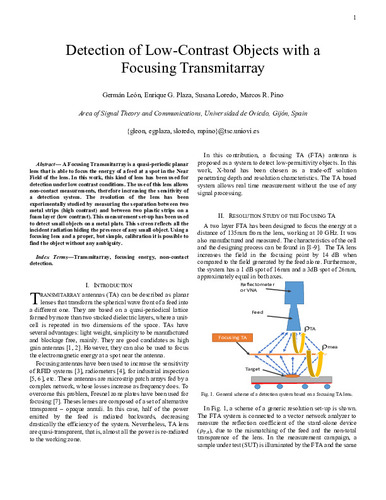Detection of Low-Contrast Objects with a Focusing Transmitarray
Autor(es) y otros:
Palabra(s) clave:
Defect detection
Near field focusing
Fecha de publicación:
Editorial:
IEEE
Versión del editor:
Resumen:
A Focusing Transmitarray is a quasi-periodic planar lens that is able to focus the energy of a feed at a spot in the Near Field of the lens. In this work, this kind of lens has been used for detection under low contrast conditions. The use of this lens allows non-contact measurements, therefore increasing the sensitivity of a detection system. The resolution of the lens has been experimentally studied by measuring the separation between two metal strips (high contrast) and between two plastic strips on a foam layer (low contrast). This measurement set-up has been used to detect small objects on a metal plate. This screen reflects all the incident radiation hiding the presence of any small object. Using a focusing lens and a proper, but simple, calibration it is possible to find the object without any ambiguity
A Focusing Transmitarray is a quasi-periodic planar lens that is able to focus the energy of a feed at a spot in the Near Field of the lens. In this work, this kind of lens has been used for detection under low contrast conditions. The use of this lens allows non-contact measurements, therefore increasing the sensitivity of a detection system. The resolution of the lens has been experimentally studied by measuring the separation between two metal strips (high contrast) and between two plastic strips on a foam layer (low contrast). This measurement set-up has been used to detect small objects on a metal plate. This screen reflects all the incident radiation hiding the presence of any small object. Using a focusing lens and a proper, but simple, calibration it is possible to find the object without any ambiguity
Descripción:
IEEE International Conference on Microwaves, Antennas, Communications and Electronic Systems (COMCAS), 13-15 noviembre de 2017, Tel-Aviv (Israel)
ISBN:
Patrocinado por:
Project MIRIIEM with ref. TEC2014-540005-P of the Ministerio de Economía y Competitividad, and the research project of the Gobierno del Principado de Asturias / FEDER with ref. GRUPIN14-114
Colecciones
Ficheros en el ítem





